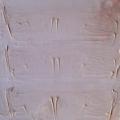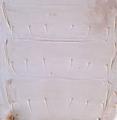Leucothrips piercei
Recognition data
Distinguishing features
Both sexes fully winged. Body, legs and wings white, antennal segments VI–VII light brown. Antennae 7-segmented, VII slender and as long as VI; sensoria simple on III–IV, segment VI with long simple sensorium arising near to base on inner margin. Head lacking sculpture. Pronotum transversely striate, with two pairs of prominent postero-angular setae of which the outer pair is longer than the inner. Metanotum with linear sculpture lines converging medially, median pair of setae small and arising medially. Tarsi all 1-segmented. Forewing slender, pointed; first vein with three widely spaced setae on distal half, second vein without setae, postero-marginal cilia straight. Abdominal tergites II–VIII median setae long and close together; lateral thirds of tergites with transverse lines of sculpture bearing weak microtrichia; VIII with postero-marginal comb of microtrichia. Sternites III–VII with three pairs of long postero-marginal setae.
Male with sensoria simple on antennal segment III–IV.
Related and similar species
Five species are recognized in the genus Leucothrips, three of which are known only from the Neotropics (Mound, 1999). As with other species of the Dendrothripinae, the metathoracic furca is enlarged and lyre-shaped, extending to the mesothorax.
Taxonomic data
Current valid name
Leucothrips piercei (Morgan)
Original name and synonyms
- Microthrips piercei Morgan, 1913: 19
Family placement
Thripidae, Dendrothripinae
Biological data
Life history
Breeding on leaves
Host plants
Possibly on the leaves of Cercis canadensis (Caesalpiniaceae).
Tospoviruses vectored
None
Crop damage
None
Distribution data
Area of origin
Possibly eastern USA
Distribution
Eastern North America, including Georgia, Florida, Mexico and California (Stannard, 1968).







